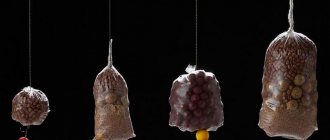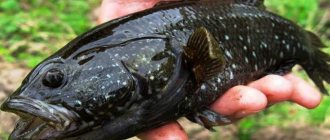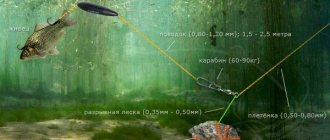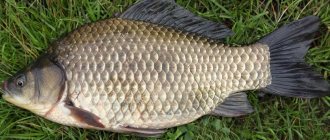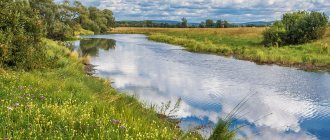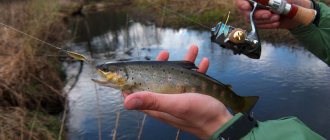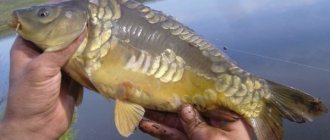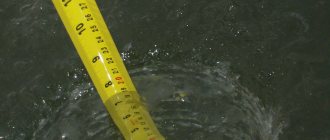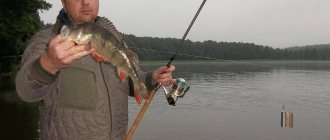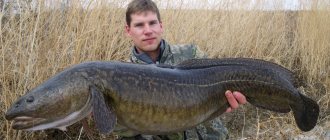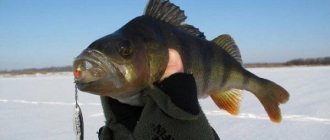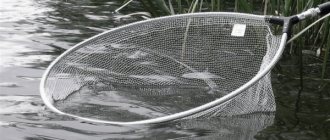Choosing gear for carp fishing
Even a novice fisherman knows that to catch carp they use much stronger gear than for other fish. A float rod with a thin leash and a sensitive float is not suitable for this task; a daring carp will simply tear it at the first tug.
Nowadays, carp fishing is very popular all over the world, which means that the gear for this type of fishing is of good quality. Fans of carp fishing know this, but for a beginner it will be difficult to make a choice. Before you go to a pond to catch carp, you should find out in more detail what gear you need to use, and how to choose a rod and reel to catch this freshwater giant.
Gear collection begins with the selection of components with the characteristics described below.
| equipment components | required characteristics |
| rod | The choice is to stop at carp fish of two parts, with indicators of 3.5-4 Lb |
| coil | power with spool 4000-6000 |
| the basis | monofilament 0.35-05 mm |
Every self-respecting carp angler has more than one rod in his arsenal, at least 2, and the ideal option would be to have 4 forms with different maximum load ratings. Next comes the installation; experienced fishermen recommend learning how to knit them yourself, then you will know exactly what quality material it is made of and how strong the connections will be.
Victoria Leshchenko
I've been working hard in the fishing tackle department for the past six years. I can help you assemble almost any gear.
Ask a Question
When choosing a fishing line for the base, pay attention to the breaking load, while each knot will reduce this indicator significantly.
1) Choosing a reservoir for carp fishing
In advance, that is, several days or weeks before going carp fishing, you need to try to collect as much information as possible about the reservoir. First of all, find out about the actual presence of carp in it and its size. Then, remotely (on forums) explore the depths and topography of the bottom, and inquire about the most successful baits. As well as other species of fish that live there. In early spring (as well as in winter), it is better to choose some small ponds and lakes. In summer, it is advisable to opt for relatively deep bodies of water.
The ideal option is to visit the pond or lake several times before starting serious fishing. Carefully examine its bottom with an echo sounder (if, of course, boats are allowed there), and watch the fish through binoculars. Take measurements of the water temperature (since the most active feeding of carp is observed at a temperature of 14-16 degrees Celsius).
And, in the end, draw a schematic map of the reservoir, on which to mark all promising points for future fishing. A few hours spent on this task during the week will significantly increase your chances of a successful result! Future places for carp fishing should be chosen not only depending on the season of the year, but also taking into account the weather (at the expected time of fishing).
Early spring
Thus, on warm spring days it is worth choosing shallow areas of the reservoir (i.e., no more than one and a half meters deep). The water there warms up faster, thereby attracting carp, which loves to “warm up” after a long winter. Most often he visits such places in the second half of the day. It is definitely worth noting that the most promising fishing spots in reservoirs in the spring are those shallow water areas where fish like to spawn. She will definitely visit them both before spawning and immediately after it.
Summer period
In hot and sultry summers, the shallow water places mentioned above will sometimes be useful only at night or early in the morning. During the day, the water here gets very hot (which reduces the amount of oxygen in it), so you need to catch carp in deep water. A warm breeze blowing in your face will bring not only normal warm water (with sufficient oxygen content in it), but also all kinds of natural food, which will certainly be followed by carp. Even a weak (but stable) breeze after a long calm can seriously activate the bite. In general, if you want to catch carp, always stand upwind.
Rainy weather
Don't rule out the possibility of carp fishing if the weather continues to be warm/rainy. Moreover, a strong (but short-term) downpour is always a harbinger of an excellent bite. Since it quickly enriches the water with oxygen and washes a lot of “goodies” from the shore into a pond or lake, the fish becomes very active. The exception is prolonged rain during periods of sharp cold weather.
Autumn season
In autumn, carp prefer deep holes. And only sometimes, on warm and sunny days, they can get out to shallow areas (if the water there warms up normally). It is important to remember that the autumn feeding period for carp is quite short. Therefore, if he pecks, it is better to immediately offer him another bait (that is, a fresher one) - to be on the safe side. In the fall, you can cast a couple of rods and leave one on the shore with bait in combat readiness. Which needs to be quickly activated immediately after the first bite signals.
Fishing using a PVA bag and boilie as bait
Not everyone knows the PVA package, and beginners don’t know exactly how to use it. This component of the gear came to carp fishing from medicine; it is made from polyethylene that dissolves quickly in water. It is used as a shell for complementary foods, namely boilies or pellets. The equipment is made so that the hook is in the middle of the PVA bag with bait, immediately after casting and contact with water the bag will dissolve, at the bottom there will be a pile of bait, and there will be a hook in it.
The package will take a different amount of time to dissolve, depending on the thickness of the fibers and the temperature of the water in the reservoir.
Among the advantages are noted:
- the bag will prevent snagging in snags;
- the hook is not visible at all to the potential trophy;
- The bait on the bottom looks pinpointed and does not scare away the carp.
You can fish with this gear in several ways:
- the floating bag is half filled with complementary food, it floats and gradually distributes the food around the hook at the bottom;
- the bag is completely filled with complementary foods, and the sinker is not used for installation;
- installation with a slowly sinking bag allows you to distribute complementary foods over a small area at the bottom.
Advice! When choosing a PVA bag or PVA sleeve, pay attention to the thickness of the fibers and its minimum dissolution time.
Carp fishing - about baits and groundbaits
21) Be a wise investor
Quite often, some anglers (especially beginners) sincerely believe that the quality of the fish bite is significantly affected by the high cost of reels and rods. But the truth is that no matter how “sophisticated” your gear is, the most important desire of fish (both 1000 years ago and today) is to eat tasty food. That is, in fact, a well-chosen, and most importantly, “tasty” bait is also important. When buying bait, never be greedy. They significantly influence both the quantity and size of your future trophies. All your investments will definitely pay off. If it so happens that today you have “idle” fishing, then be sure that the place is well baited. And tomorrow (or the other day) everything will be fine. Consider that you have made an investment - laid a solid foundation for future success.
22) Avoid templates
“Turn on” creativity - try not to do “like everyone else”, look for new ways. According to ichthyologists, carp are very faithful to their habits. Therefore, individuals from one body of water “firmly” get used to one diet, while individuals from a neighboring one – to a completely different one. Much depends on what the fishermen fed them. However, not a single living creature will ever refuse a more delicious treat. Experiment with baits: “play” with colors and shapes, try different types of flavors (both liquid and dry). If you were a carp, what would you like?
Fishing with a feeder "Method"
Method feeders have several varieties, but what they all have in common is the way they load complementary foods. The prepared complementary food is placed in the mold, the feeder itself is placed on top and pressed tightly.
Installation of the feeder is carried out as follows:
- an anti-twist made of plastic or metal is placed on the main one, then a rubber cone is placed, which acts as a latch for the feeder;
- the fishing line is passed through the center of the feeder and attached to the swivel;
- the swivel is placed in the feeder so that it jumps out of it on its own;
- the hook is tied to the leash.
Installation is not difficult; even a beginner in fishing can handle it.
Liquids
A few words about the use of liquids. Liquid is called liquid bait, designed to increase the efficiency of bait or bait. It is important not to exceed the dosage indicated on the packaging by the manufacturer; if you exceed it, you may get the opposite effect. Most often, the dosage volume for highly attractive liquids ranges from thirty to fifty milliliters per 1 kilogram of bait. Cut the boiled boilies, fill them with a small amount of water from the reservoir, add the liquid of the same name, stir so that the liquid is homogeneous. In just a couple of hours, your boilies will be saturated and ready to emit powerful signals to quickly attract fish.
Liquid nutrition Booster Liquid Food Dark Plum dark plum, 500 ml RHINO BAITS 659 for 1 pc. Liquid nutrition Bait Booster Liquid Food Super Strawberry super strawberry, 500 ml RHINO BAITS 593 for 1 piece. Liquid nutrition Booster Liquid Food Monster Crab monster crab, 1200 ml RHINO BAITS 989 for 1 piece. Liquid nutrition Booster Liquid Food C-4 citrus 500 ml RHINO BAITS 593 for 1 pc. Liquid nutrition Booster Liquid Food Pineapple N-Butyric pineapple, 500 ml RHINO BAITS 593 for 1 pc.
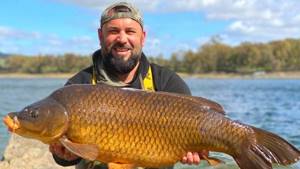
Feeder equipment
In carp fishing, feeder equipment is also used, more often in the current, but no less effective for still water. A special feature of the gear is that classical methods do not allow feeding fish in the current, but feeder methods do the opposite.
For carp fishing, a couple of methods are most often used that give the greatest efficiency.
Helicopter and two knots
This installation is used for a feeder when fishing in the current; with its help, catching large fish occurs much more often. The basis of the installation is a sinker on a plastic tube, onto which a leash with a hook is attached. Experienced carp anglers often recommend this particular installation for their students.
Paternoster
The paternoster loop is more suitable for fishing on a muddy bottom; in addition, it is often used when collecting gear for a feeder for the current. It has proven itself no worse in standing water.
Tackle Everyone chooses the tackle for their own fishing rod, but it is advisable to have several options for ready-made equipment.
Carp fishing methods
Real lovers of carp fishing have long ago acquired modern products for feeding. Most often, professional carp anglers encounter:
- “Rocket” feeders, which differ in shape for flow and standing water. At first glance, they really resemble a rocket in shape, which allows you to cast 130-150 m from the shore.
- A slingshot is often used to deliver feed; it can be purchased at almost every fishing tackle store. This method of delivering complementary foods is recommended only in bodies of water with standing water. First, balls are formed from the bait mixture, which are then delivered to the required place.
Important! When choosing a “Rocket” for feeding, the main thing is to choose the right model. A closed bottom is used for currents, and an open bottom is used for standing water.
Fishing technology
Carp is cunning. He will be where no one expected him, so you need to be prepared to move and change your fishing location often.
You need to know the nature of the bottom.
This is where this fish lives, which means that at least a rough idea of where the slopes and cliffs are will help to better hide the fishing line and increase the likelihood of catching prey. Reference. If the bait and fishing method work, there is no need to change them. If not, you should continue experimenting - experience will gradually come. If your comrades are not biting, you should try something different from their bait or complementary food. If there are a lot of fishermen, you can cast your fishing rod further away - the fish has clearly moved away from the shore.
Traditional
Feeder feeding is the process of delivering food to a given point at least 10 times, using a large open-type feeder without a leash or hook.
The process is not complicated, which is perhaps why it is so popular among fishermen. A large open feeder is tied to the rod, filled with complementary food and lightly pressed on both sides. The rod is immediately placed on the stand at an angle of 45 degrees relative to the fishing line, in this position it should be taut. As soon as the line weakens, the feeder has reached the bottom. During this period, it is necessary to clip the line; on the next cast, this will help deliver the feed to the same distance.
10 seconds after this, it is necessary to make a sharp hook, so the bait will end up on the bottom. This process is carried out another 8-12 times. Then they tie on the main gear and start fishing.
Carp bait
The only bait for the finished tackle is boilies. Some people use pellets or granules with elastic, but this will not be the same.
Boilies have many advantages over other baits:
- size, it immediately cuts off small fish;
- dark color, which is considered the most successful and attractive for large carp ;
- variety of tastes, different types are selected for each season;
- different buoyancy, there are sinking, floating and dusting boilies, each of these types will work differently, which will attract more fish.
Advice! It is worth choosing boilies in a store or making them yourself, taking into account the gastronomic preferences of the carp. In the spring and autumn, their composition should include protein, but in the summer, fruit-flavored balls will work better.
A lot can be said regarding size, but each body of water is individual. Of course, you shouldn’t use very small ones, but a large boilie may not always work. It is best to choose a medium size, approximately 8-12 mm in diameter. Lures of this type in Deep get good reviews; they are more flavored.
Pellets
Pellets - granular bait. There are a huge number of manufacturers and types of pellets. It is important that the granule is fresh and does not exceed its shelf life. Oddly enough, the already highly attractive pellets can be “charged” with liquid nutrition. A mixture of Golden Liquid oils, Rhinamino (an amino acid supplement) and the appetite stimulant RHINO STIM will strengthen and accelerate the process of attracting fish to your swim, and will also help the fish return to your swim to feed more and more. It is important to remember that fish oils work well in warm water, but in cold water they clog your bait!
Dusting boilies
. Take dusty boilies from the line of the same name with you to the session. The work of dust boilies is to gradually dissolve the top layer of the boilie. Carp is a very curious fish, gurgling through the water and the effect of “sweet water” very often give immediate results.
